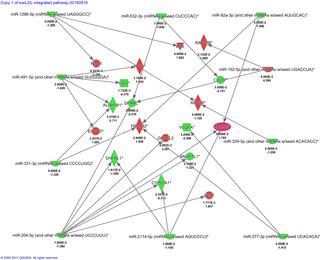PLOS ONE ( IF 2.9 ) Pub Date : 2019-03-15 , DOI: 10.1371/journal.pone.0213494 Genesio M Karere 1, 2 , Jeremy P Glenn 1 , Shifra Birnbaum 1 , Roy Garcia 1 , John L VandeBerg 3 , Laura A Cox 1, 2, 4

|
Rationale
Plasma low-density lipoprotein cholesterol (plasma LDL-C), vascular endothelial cells and peripheral blood mononuclear cells (PBMCs), particularly monocytes, play key roles in initiating atherosclerosis, the primary cause of cardiovascular disease (CVD). Although the mechanisms underlying development of atherosclerosis are not well understood, LDL-C is known to influence expression of endothelial microRNAs (miRNAs) and gene-targets of miRNAs to promote cell senescence. However, the impact of LDL-C on expression of PBMC miRNAs and miRNA targeted genes in response to an atherogenic diet is not known. In this study, we used unbiased methods to identify coordinately responsive PBMC miRNA- gene networks that differ between low and high LDL-C baboons when fed a high-cholesterol, high-fat (HCHF) diet.
Methods and results
Using RNA Seq, we quantified PBMC mRNAs and miRNAs from half-sib baboons discordant for LDL-C plasma concentrations (low LDL-C, n = 3; high LDL-C, n = 3) before and after a 7-week HCHF diet challenge. For low LDL-C baboons, 626 genes exhibited significant change in expression (255 down-regulated, 371 up-regulated) in response to the HCHF diet, and for high LDL-C baboons 379 genes exhibited significant change in expression (162 down-regulated, 217 up-regulated) in response to the HCHF diet. We identified 494 miRNAs identical to human miRNAs and 47 novel miRNAs. Fifty miRNAs were differentially expressed in low LDL-C baboons (21 up- and 29 down-regulated) and 20 in high LDL-C baboons (11 up- and 9 down-regulated) in response to the HCHF diet. Among the differentially expressed miRNAs were miR-221/222 and miR-34a-3p, which were down-regulated, and miR-148a/b-5p, which was up-regulated. In addition, gene-targets of these miRNAs, VEGFA, MAML3, SPARC, and DMGDH, were inversely expressed and are central hub genes in networks and signaling pathways that differ between low and high LDL-C baboon HCHF diet response.
Conclusions
We have identified coordinately regulated HCHF diet-responsive PBMC miRNA-gene networks that differ between baboons discordant for LDL-C concentrations. Our findings provide potential insights into molecular mechanisms underlying initiation of atherosclerosis where LDL-C concentrations influence expression of specific miRNAs, which in turn regulate expression of genes that play roles in initiation of lesions.
中文翻译:

狒狒中 LDL-胆固醇不一致的协调调节 microRNA 基因网络的鉴定
基本原理
血浆低密度脂蛋白胆固醇(血浆 LDL-C)、血管内皮细胞和外周血单核细胞(PBMC),特别是单核细胞,在引发动脉粥样硬化(心血管疾病(CVD)的主要原因)方面发挥着关键作用。尽管动脉粥样硬化发展的机制尚不清楚,但已知 LDL-C 会影响内皮 microRNA (miRNA) 和 miRNA 的基因靶标的表达,从而促进细胞衰老。然而,LDL-C 对 PBMC miRNA 和 miRNA 靶基因表达(响应致动脉粥样硬化饮食)的影响尚不清楚。在这项研究中,我们使用公正的方法来识别在高胆固醇、高脂肪 (HCHF) 饮食下,低 LDL-C 狒狒和高 LDL-C 狒狒之间的协调响应 PBMC miRNA 基因网络的差异。
方法和结果
使用 RNA Seq,我们对 7 周 HCHF 饮食前后 LDL-C 血浆浓度不一致的半同胞狒狒的 PBMC mRNA 和 miRNA 进行了定量(低 LDL-C,n = 3;高 LDL-C,n = 3)挑战。对于低 LDL-C 狒狒,响应 HCHF 饮食,626 个基因表现出表达显着变化(255 个下调,371 个上调),而对于高 LDL-C 狒狒,379 个基因表现出表达显着变化(162 个下调)。第217章 上调)响应HCHF饮食。我们鉴定了 494 个与人类 miRNA 相同的 miRNA 和 47 个新的 miRNA。响应 HCHF 饮食,低 LDL-C 狒狒中有 50 种 miRNA(21 种上调,29 种下调)和高 LDL-C 狒狒中 20 种(11 种上调和 9 种下调)差异表达。差异表达的 miRNA 包括下调的 miR-221/222 和 miR-34a-3p,以及上调的 miR-148a/b-5p。此外,这些 miRNA 的基因靶标VEGFA 、 MAML3 、 SPARC和DMGDH呈反向表达,并且是低和高 LDL-C 狒狒 HCHF 饮食反应不同的网络和信号通路中的中心基因。
结论
我们已经确定了协调调节的 HCHF 饮食响应 PBMC miRNA 基因网络,该网络在 LDL-C 浓度不一致的狒狒之间有所不同。我们的研究结果为动脉粥样硬化起始的分子机制提供了潜在的见解,其中 LDL-C 浓度影响特定 miRNA 的表达,从而调节在病变起始中发挥作用的基因的表达。











































 京公网安备 11010802027423号
京公网安备 11010802027423号